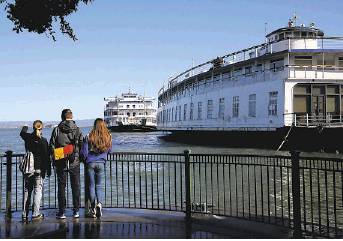As king tide hits peak, museum explores dangers
By Anna Bauman
Water lapped inches beneath the low-lying sidewalk at San Francisco’s Embarcadero until a boat cruised by.
Suddenly, a cresting wave gushed over the edge, sending a shrieking group of onlookers scurrying for dry land in soaked shoes.
“The tide finally got us,” Lori Lambertson said. “This is what we were hoping for.”
The king tide — one of the highest tides in the year — reached its peak shortly before noon Saturday near the Embarcadero’s Pier 3, where more than 100 people gathered to watch it. The Exploratorium, a science museum at Pier 15, hosted a presentation to demonstrate the dangers of future high tides as sea levels continue rising, along with global temperatures.
Lambertson, an Exploratorium staff instructor, used displays and interactive demonstrations to explain how it works.
Tides are caused by the gravitational pull of the sun and moon and are affected by weather conditions, she said.
Three factors collide to create the extreme tides. The sun and moon must align along the same gravitational pull — a full moon — and both must be at their closest point to the Earth.
That’s exactly what happened last week, when the predicted tidal height at the Golden Gate bridge was 6.94 feet at its peak. Low tide later in the day was expected to be 8 feet below high tide.
“Crazy,” Lambertson said. “Our normal tide range is 6-ish feet, so 8 feet is extreme.”
Still, blue skies meant the waters in the bay were relatively calm. Storm and wind would have created more wave action, she said.
“It’s not as dramatic as it could have been because of weather effects,” Lambertson said.
The curious onlookers visited the Embarcadero Saturday to watch a rare occurrence that happens a few times each year, but Lambertson said these tides will become much more common as sea levels creep higher and higher.
“Today’s king tides are tomorrow’s regular high tides,” she said.
David Beaupre, a planner for San Francisco’s port, followed the science lesson with a presentation showing how rising waters could devastate the city’s waterfront.
In the past 100 years, sea levels in San Francisco rose roughly 8 inches, according to the Exploratorium. If the pattern continues, as scientists predict it will, the Embarcadero would be under water in the next 100 years. BART and Muni could be flooded, sewage systems that serve the northeast quadrant of the city could be overwhelmed, and historic resources may be lost.
The seawall along the Embarcadero, built in 1906 before seismic codes existed, could experience liquefaction during a large earthquake, Beaupre said.
“After 100 years, it’s beginning to fail,” he said, pointing to a picture of eroded seawall.
Lambertson encouraged people to take pictures when they see king tides and submit them to the California King Tides Project. Scientists will use the photos to help plan for high sea levels in the future.
Beaupre said the city is working on a project to reinforce the seawall and the Army Corps of Engineers is conducting a project to identify flood risks.
Marian McNairy of Oakland brought her two grandchildren to the presentation. Her 10year-old grandson, Kalil Jones, threw an arm around his sister as they squinted in the sunlight.
“Maybe it’s going to be a water world,” he speculated.
The kids said they are worried about sea level rise, but McNairy hoped the presentation would have a more positive effect.
“Maybe when they get of age, they may want to consider a career” in science, she said. “They may do something to prevent it.”
The family was one of several from Markham Elementary School in Oakland. Science teacher Aaron Reaven said his third-, fourth- and fifth-grade students are studying sea level rise.
“I wanted them to see that it’ll actually have an effect,” he said. “They’ll be able to see the ocean taking over the sidewalk.”
Anna Bauman is a San Francisco Chronicle staff writer. Email: anna.bauman@sfchronicle.com Twitter: @abauman2
